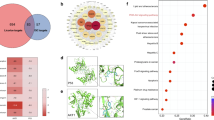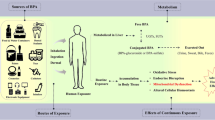Abstract
Occupational heart disease have occurred continuously, making social problems, and increasing the needs for its effective prevention. As natural antioxidants, selenium (Na2SeO3) and cerium oxide (CeO2) nanoparticles, we verified the effect with suspected cardiotoxic chemicals, 1,1,1-trichloroethane (TCEtn) based on the myocardial cell line due to inflammation and oxidative DNA damage, and reliable anti-cardiotoxic effects of selenium and CeO2 nanoparticles. We measured the changes of gene expression with real-time RT-PCR, and oxidative DNA damage with Fragment Length Analysis with Restriction Enzyme (FLARE) assay in H9c2 cell line, and discuss their molecular mechanism from these data. In the result, it has anticytotoxic effect with CeO2 nanoparticles below 100 μM which the particles dispersed well. The early expression of COX2 mRNA is increased with TCEtn but decreased with Na2SeO3, CeO2 nanoparticles, has some anti-inflammatory effect. The PPARγ is much increased with all of TCEtn, Na2SeO3, CeO2 nanoparticles in 36 hour pretreat, are evaluated their activation to cytokines, transcription factors related to overcome and decrease the cardiotoxic effects of test chemical. With the oxidative DNA damage, the CeO2 nanoparticles have more active anti-oxidative effect to selenium.
Similar content being viewed by others
References
Solet, D., Robins, T. G. & Sampaio, C. Perchloroethylene exposure assessment among dry cleaning workers. Am Ind Hyg Assoc J 51:566 (1990).
Schwartz, S. Principles of Drycleaning. International Fabricare Institute. Industry Focus, No. 6, November, Washington, D.C., USA ( 1997).
Alan, H. S. Encyclopedia Americana, Vol. 4. Grolier Inc., Danbury, CT, USA (1994).
Ercal, N., Gurer-Orhan, H. & Aykin-Burns, N. Toxic metals and oxidative stress part I: mechanisms involved in metal-induced oxidative damage. Curr Top Med Chem 1:529–539 (2001).
Han, S. G. et al. Correlates of oxidative stress and freeradical activity in serum from asymptomatic shipyard welders. Am J Respir Crit Care Med 172:1541–1548 (2005).
Stewart, R. D. Acute tetrachloroethylene intoxication. JAMA 208:1490 (1969).
Park, E. J., Choi, J., Park, Y. K. & Park, K. Oxidative stress induced by cerium oxide nanoparticles in cultured BEAS-2B cells. Toxicology 245:90–100 (2008).
Niu, J., Azfer, A., Rogers, L. M., Wang, X. & Kolattukudy, P. E. Cardioprotective effects of cerium oxide nanoparticles in a transgenic murine model of cardiomyopathy. Cardiovasc Res 73:549–559 (2007).
Chen, J., Patil, S., Seal, S. & McGinnis, J. F. Rare earth nanoparticles prevent retinal degeneration induced by intracellular peroxides. Nat Nanotechnol 1:142–150 (2006).
Younce, C. W. & Kolattukudy, P. E. MCP-1 causes cardiomyoblast death via autophagy resulting from ER stress caused by oxidative stress generated by inducing a novel zinc-finger protein, MCPIP. Biochem J 426:43–53 (2010).
Teli, M. K., Mutalik, S. & Rajanikant, G. K. Nanotechnology and nanomedicine: going small means aiming big. Curr Pharm Des 16:1882–1892 (2010).
Gómez-Aracena, J. et al. Toenail cerium levels and risk of a first acute myocardial infarction: the EURAMIC and heavy metals study. Chemosphere 64:112–120 (2006).
Eapen, J. T. Elevated levels of cerium in tubers from regions endemic for endomyocardial fibrosis (EMF). Bull Environ Contam Toxicol 60:168–170 (1998).
Holler, N. et al. Fas triggers an alternative, caspase-8-independent cell death pathway using the kinase RIP as effector molecule. Nat Immunol 1:489–495 (2000).
Mates, J. M. & Sanchez-Jimenez, F. Antioxidant enzymes and their implications in pathophysiologic processes. Front Biosci 4:D339–345 (1999).
Eom, H. J. & Choi, J. Oxidative stress of CeO2 nanoparticles via p38-Nrf-2 signaling pathway in human bronchial epithelial cell, Beas-2B. Toxicol Lett 187:77–83 (2009).
Lin, W., Huang, Y. W., Zhou, X. D. & Ma, Y. Toxicity of cerium oxide nanoparticles in human lung cancer cells. Int J Toxicol 25:451–457 (2006).
Geiser, M. et al. Ultrafine particles cross cellular membranes by nonphagocytic mechanisms in lungs and in cultured cells. Environ Health Perspect 113:1555–1560 (2005).
Manolio, T. Novel risk markers and clinical practice. N Engl J Med 349:1587–1589 (2003).
Gotto, Jr. A. M. Role of C-reactive protein in coronary risk reduction: focus on primary prevention. Am J Cardiol 99:718–725 (2007).
Singh, N., Cohen, C. A. & Rzigalinski, B. A. Treatment of neurodegenerative disorders with radical nanomedicine. Ann NY Acad Sci 1122:219–230 (2007).
Tarnuzzer, R. W., Colon, J., Patil, S. & Seal, S. Vacancy engineered ceria nanostructures for protection from radiation-induced cellular damage. Nano Lett 5:2573–2577 (2005).
Pirmohamed, T. et al. Nanoceria exhibit redox statedependent catalase mimetic activity. Chem Commun 46:2736–2738 (2010).
Colon, J. et al. Protection from radiation-induced pneumonitis using cerium oxide nanoparticles. Nanomedicine: Nanotechnology, Biology and Medicine 5:225–231 (2009).
Kyriakis, J. M. & Avruch, J. Mammalian mitogen-activated protein kinase signal transduction pathways activated by stress and inflammation. Physiol Rev 81:807–869 (2001).
Wang, S. AMPKalpha2 deletion causes aberrant expression and activation of NAD(P)H oxidase and consequent endothelial dysfunction in vivo: role of 26S proteasomes. Circ Res 106:1117–1128 (2010).
Jeong, H. W. et al. Berberine suppresses proinflammatory responses through AMPK activation in macrophages. Am J Physiol Endocrinol Metab 296:E955–964 (2009).
Ouslimani, N. et al. Metformin decreases intracellular production of reactive oxygen species in aortic endothelial cells. Metabolism-Clinical And Experimental 54:829–834 (2005).
Brown, P. J. et al. Identification of peroxisome proliferators-activated receptor ligands from a biased chemical library. Chem Biol 4:909–918 (1997).
Michalik, L. et al. PPAR expression and function during vertebrate development. Int J Dev Biol 46:105–114 (2002).
Lee, C. H., Olson, P. & Evans, R. M. Minireview: lipid metabolism, metabolic diseases, and peroxisome proliferator-activated receptors. Endocrinology 144:2201–2207 (2003).
Smeets, P. J. et al. Inflammatory pathways are activated during cardiomyocyte hypertrophy and attenuated by peroxisome proliferator-activated receptors PPAR α and PPAR?. J Biol Chem 283:29109–29118 (2008).
Planavila, A. et al. Peroxisome proliferator-activated receptor beta/delta activation inhibits hypertrophy in neonatal rat cardiomyocytes. Cardiovasc Res 65:832–841 (2005).
Antje, D., Cornelia, D., Oliver, M., Felix, B. & Katharina, R. L. S. Hypothermia protects H9c2 cardiomyocytes from H2O2 induced apoptosis. Cryobiology 62:53–61 (2011).
Hirst, S. M. et al. Bio-distribution and in vivo antioxidant effects of cerium oxide nanoparticles in mice. Environmental Toxicology (2011). [Article first published online: 26 MAY 2011, DOI: 10.1002/tox.20704].
Xia, T. K. et al. Comparison of the mechanism of toxicity of zinc oxide and cerium oxide nanoparticles based on dissolution and oxidative stress properties. ACS Nano 2:2121–2134 (2008).
Fajas, L. et al. The organization, promoter analysis, and expression of the human PPARgamma gene. J Biol Chem 272:18779–18789 (1997).
Mukherjee, R., Jow, L., Croston, G. E. & Paterniti, J. R. Jr. Identification, characterization, and tissue distribution of human peroxisome proliferator-activated receptor (PPAR) isoforms PPARγ2 versus PPARγ1 and activation with retinoid X receptor agonists and antagonists. J Biol Chem 272:8071–8076 (1997).
Yu, K. et al. Differential activation of peroxisome proliferator-activated receptors by eicosanoids. J Biol Chem 270:23975–23983 (1995).
Stumvoll, M. & Haring, H. U. Glitazones: clinical effects and molecular mechanisms. Ann Med 34:217–224 (2002).
Subbaramaiah, K., Lin, D. T., Hart, J. C. & Dannenberg, A. J. Peroxisome proliferator-activated receptor gamma ligands suppress the transcriptional activation of cyclooxygenase-2: evidence for involvement of activator protein-1 and CREB-binding protein/p300. J Biol Chem 276:12440–12448 (2001).
Goetze, S. et al. PPAR gamma-ligands inhibit migration mediated by multiple chemoattractants in vascular smooth muscle cells. J Cardiovasc Pharmacol 33:798–806 (1999).
Lee, C. H. et al. Transcriptional repression of atherogenic inflammation: modulation by PPAR?. Science 302:453–456 (2003).
Staels, B. & Fruchart, J. C. Therapeutic roles of peroxisome proliferator-activated receptor agonists. Diabetes 54:2460–2470 (2005).
Barger, P. M. & Kelly, D. P. PPAR signaling in the control of cardiac energy metabolism. Trends Cardiovasc Med 10:238–245 (2000).
Duan, S. Z., Ivashchenko, C. Y., Russell, M. W., Milstone, D. S. & Mortensen, R. M. Cardiomyocyte-specific knockout and agonist of peroxisome proliferator-activated receptor-gamma both induce cardiac hypertrophy in mice. Circ Res 97:372–379 (2005).
Mroz, R. M. et al. Nanoparticle carbon black driven DNA damage induces growth arrest and AP-1 and NF-κB DNA binding in lung epithelial A549 cell line. J Phys and Pharmacol 58:461–470 (2007).
Olive, P. L. & Banath, J. P. Detection of DNA double-strand breaks through the cell cycle after exposure to X-rays, bleomycin, etoposide and 125IdUrd. Int J Radiat Biol 64:349–358 (1993).
Author information
Authors and Affiliations
Corresponding author
Rights and permissions
About this article
Cite this article
Rim, K.T., Kim, S.J., Song, S.W. et al. Effect of cerium oxide nanoparticles to inflammation and oxidative DNA damages in H9c2 cells. Mol. Cell. Toxicol. 8, 271–280 (2012). https://doi.org/10.1007/s13273-012-0033-5
Received:
Accepted:
Published:
Issue Date:
DOI: https://doi.org/10.1007/s13273-012-0033-5




